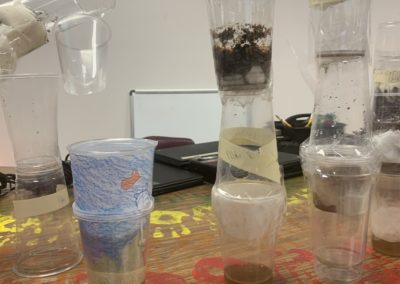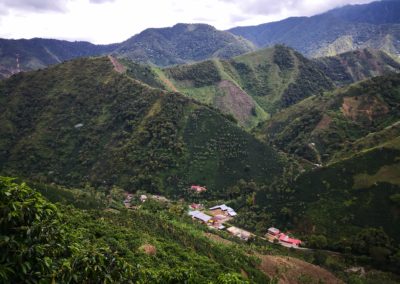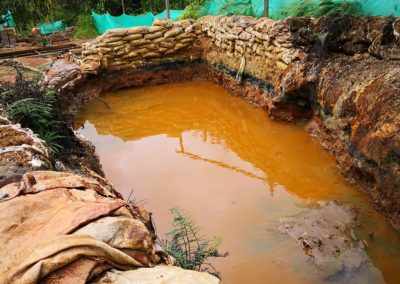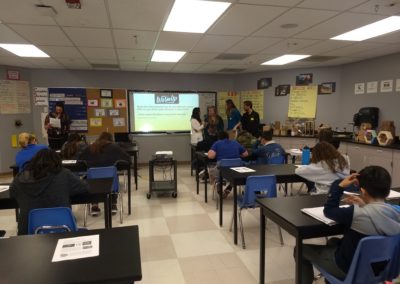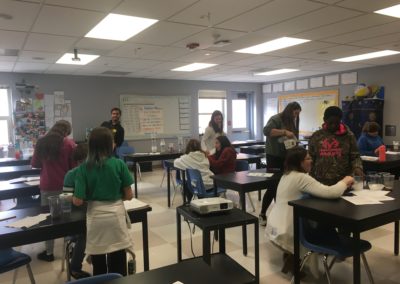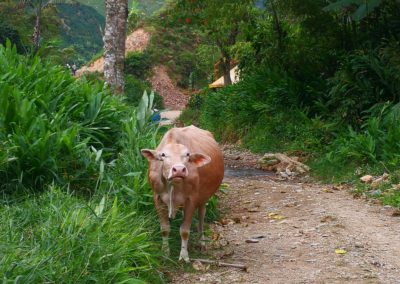Colombia STEM Education – Community Centered Design Studio
Overview
Community Advancement for Santa Rita Education (CARE)
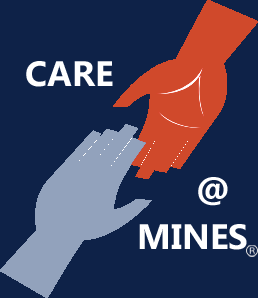
The team was tasked with finding ways to support continued education in the Santa Rita community. After receiving extensive amounts of community feedback on what mothers and community leaders wanted, the team made a STEM education plan. This plan focuses on the 9-12 age group and the hands on aspect of prototyping and problem solving. The program has the students look at how a water filter is used and implements the design process in the students’ own creation of a rudimentary water filter. The program was tested at multiple middle and elementary schools to better understand the flaws and strengths, with the intent of testing on the ground at the school in Santa Rita. Iterations were made on the program after feedback from in person testing and teachers. Our program provides a unique solution to an educational problem through an economical implementation of the engineering design process.
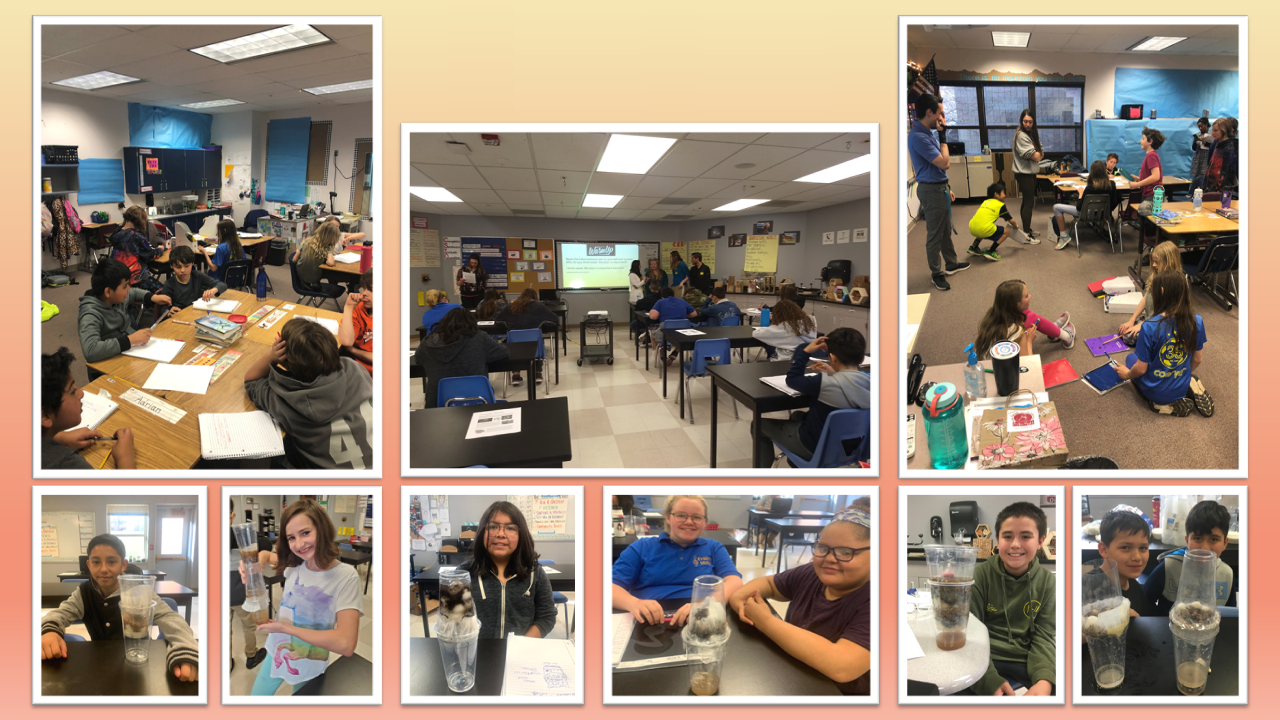
Team Members
- Juliana Anderson
- Madison Anderson
- Emerson Collins
- Arielle Rainey
- Bilal Reza
- Alex Vo
The Client
- La Corporación Universitaria Minuto de Dios (UNIMINUTO)
Acknowledgements
Project Advisors: Dr. Beth Reddy and Dr. Alina Handorean
Technical Advisors: Dr. Christopher Bellona and Dr. Stephanie Claussen
Additional Acknowledgements: Dr. Juan Lucena and Julia Roos
Donations Made by: Various Crowdfunding Donors, Humanitarian Engineering, Office of International Programs
Video
Elevator Pitch
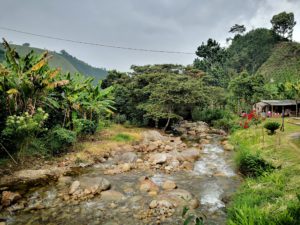
We decided to pursue an educational program that addresses water contamination due to coffee production byproducts. A significant portion of this work was able to be completed, with plans in place for a successive team to continue this work so as to ensure a meaningful and impactful project is implemented.
Design Approach
Throughout the process of researching and engaging with stakeholders, we came up with three primary issues to address and select from. These included the issue of water contamination from waste generated through coffee bean production along with contamination from gold mine-related waste. The last of these issues was waste management in a community with limited resources available for scaled city-wide management.
After a long period of contemplation, we decided to avoid having a single prototype as the primary target, due to a lack of need. Instead, the idea most team members agreed upon was to develop a STEM-based educational activity that students can engage in, with various smaller prototypes which can support this program.
Ideas for modules which could be used in the school to engage students include: a lab kit integrating water contamination remediation and filtration, a robotics module which could implement and demonstrate water contamination remediation, and a waste-cleanup robot which the students could potentially build and engage with which would provide an educational experience centered around waste management.
We detailed an overall process for our team to use that helped us pursue the development of these educational activities and used a flowchart to fine-tune our wide reaching goal into a single manageable concept.
Our research was utilized to inform our decision about which concept to select. The primary overarching theme of our project is STEM education and opportunity. STEM projects and programs have been proven to impact student interest. STEM education has the ability to impact both individuals and groups by explaining the world around them and introducing solutions to some of the technical problems communities face. We took this wide-reaching goal and began to narrow it down through significant stakeholder outreach and feedback.
We spoke with Viviana Garzon and Nicolas Mantilla at Uniminuto to collect their opinions. They spoke about issues ranging from water contamination to mining runoff and potential problems with waste management in the area.
“Motivate people to determine their passions and what moves them. Show them that there is so much they can discover through education.”
– Alejo Delgado-Jiménez, Graduate Student Colorado School of Mines
We also interviewed graduate students who have visited Santa Rita. Jeison Delgado-Jimenez (Alejo) was passionate about student involvement. One thing he said that stuck with our team and guided us through our project was: “Motivate people to determine their passions and what moves them. Show them that there is so much they can discover through education.” From that point on, we used that statement as a compass to ensure we were headed in the right direction. Rosalie O’Brien also helped us take steps toward problem definition and concept selection by informing us of issues she had observed in the community such as water contamination as a result of the coffee harvest and job instability in the area. After talking with Rosalie and Alejo, it seemed like trash was not as significant a problem in Santa Rita itself.
17 out of 21 surveys named water contamination as the biggest issue the community faces
Our most valuable insight came directly from the community. We received 21 responses to the survey we put together and was administered to family members in the St. Rita community by Diana Restrepo, a representative of the Instituto Colombia de Bienestar Familia (ICBF). An overwhelming majority, 17 out of 21 surveys, named water contamination as the biggest issue the community faces. This helped us narrow our concepts down to water contamination from mining runoff or water contamination from coffee fruit. When considering other design teams working in Santa Rita to address the mining industry, we felt our efforts would be best applied to water contamination from coffee fruit.
We also used a decision matrix to quantify the technical consideration for each of the concepts proposed. All seven criteria were evenly weighted when determining their impact on our decision because all seven highlight important parts of a successful project that sufficiently addresses the needs of the community.
Decision Matrix for Design Concept Selection
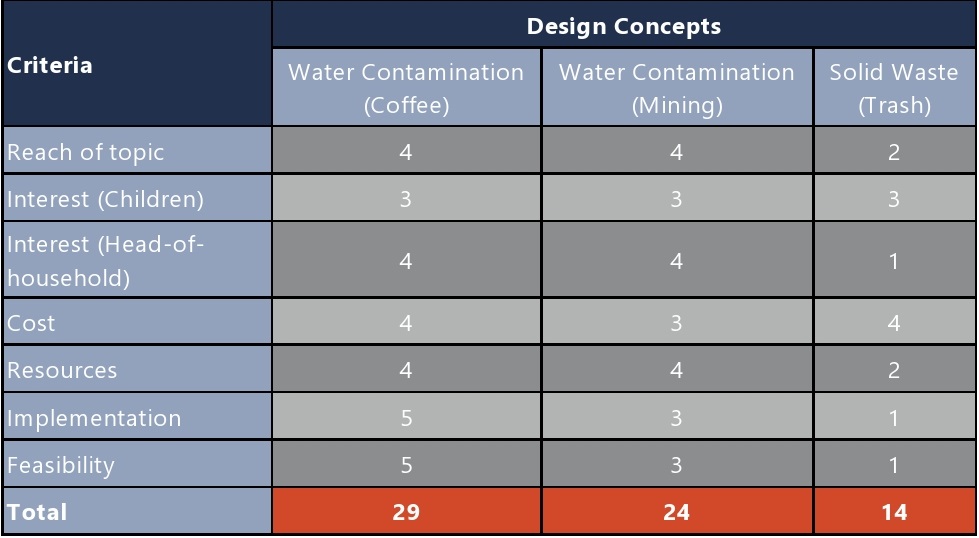
Our team’s strength lies in water treatment and contamination remediation since half of the members are environmental engineering majors. Choosing the solid waste concept would rely heavily on mechanical skills which would apply pressure to the only mechanical engineering student on our team – hence it’s score of 1. We believe we are more equipped to address water contamination issues effectively. Water contamination from coffee fruit is a simpler chemical process based on the production of acid. Due to its simple nature, it would be a more effective teaching tool for young children, earning a score of 5. Mining contamination requires more reliance on complex chemistry and more detailed remediation techniques. It is feasible but ultimately more challenging and received a score of 3.
In the end, we believed that water contamination from coffee fruit was the concept with the greatest possibility for success and execution by the CARE Team.
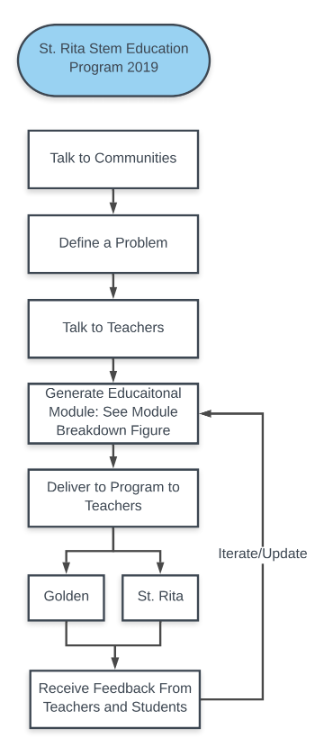
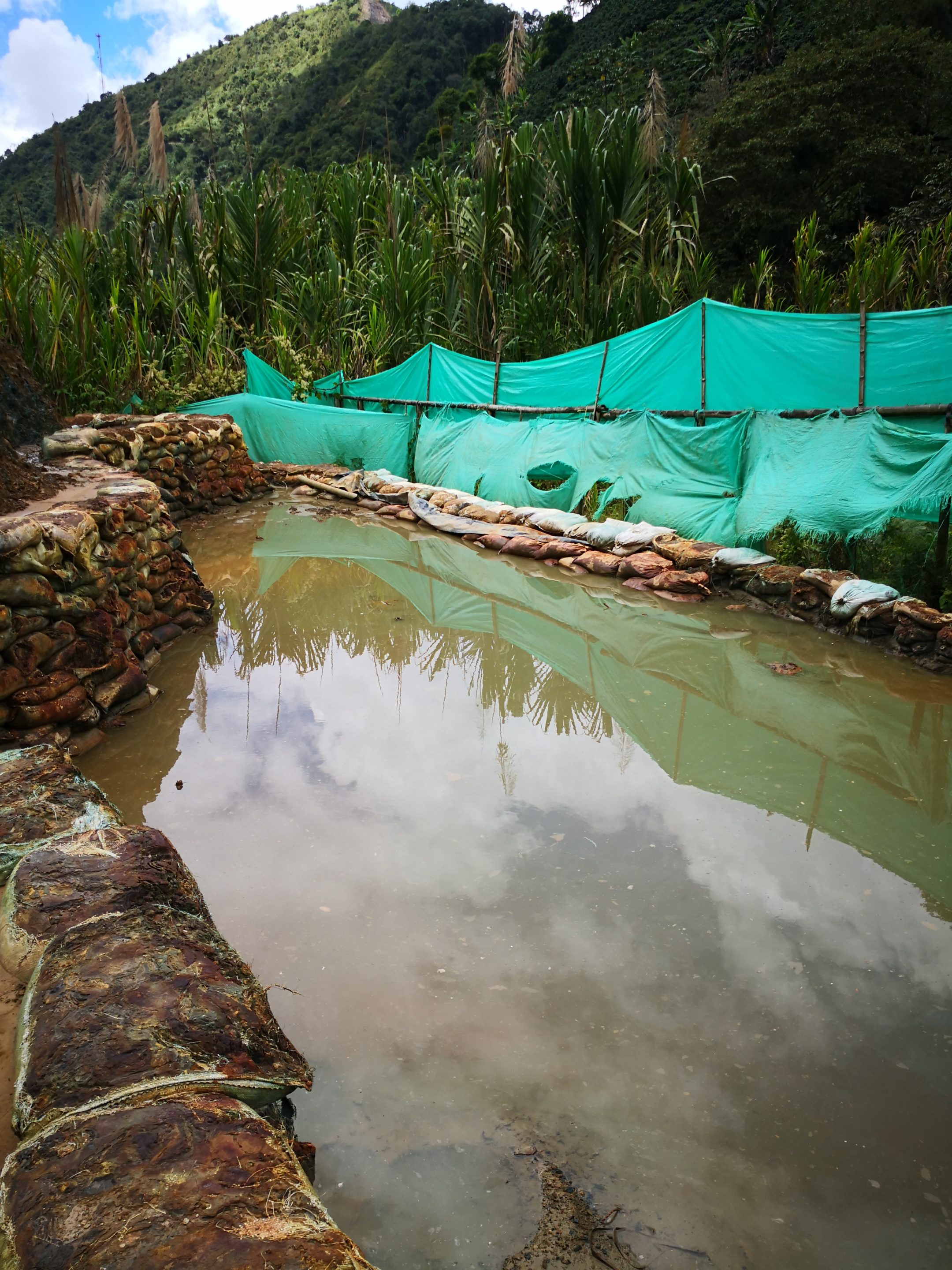
Design Solution
Design Solution
Module 1 Daily Schedule:
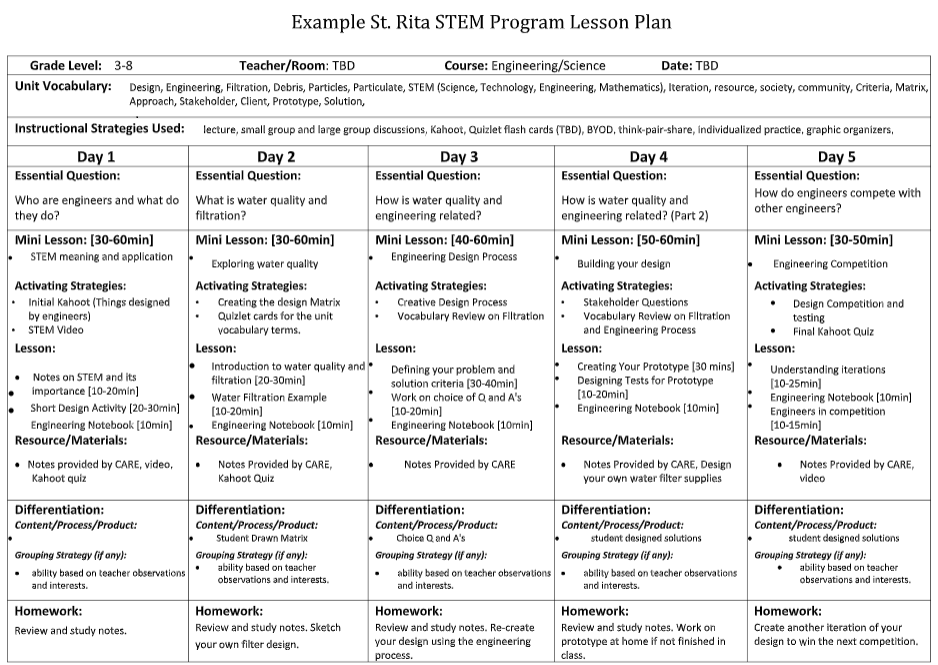
Benefits and value to the educational program:
- Low cost educational module
- Inspires students to pursue STEM
- Keeps students interested by utilizing healthy competition
- Provides an easy-to-implement program for teachers that may not have access to a STEM educational module
- Fun module designed to help inspire students at schools with low-retention rates
- Adaptable program designed for all types of classes
Testing:
Our team realized the importance of testing the program in order to address any problems and iteration to improve the process based on user feedback. For this reason, we worked with Shelton Elementary School, Everitt Middle school and Monument Academy to test our program. We used a different approach at each of the schools to test the module’s adabilty and performance variability.
“The children loved it! There was never a time during the module that the children were not engaged. The program is very adaptable and leaves a good amount of information for the teachers to take and adapt or remove based on their students.”
– Nathan Piotrowski, 5th Grade Teacher at Monument Academy
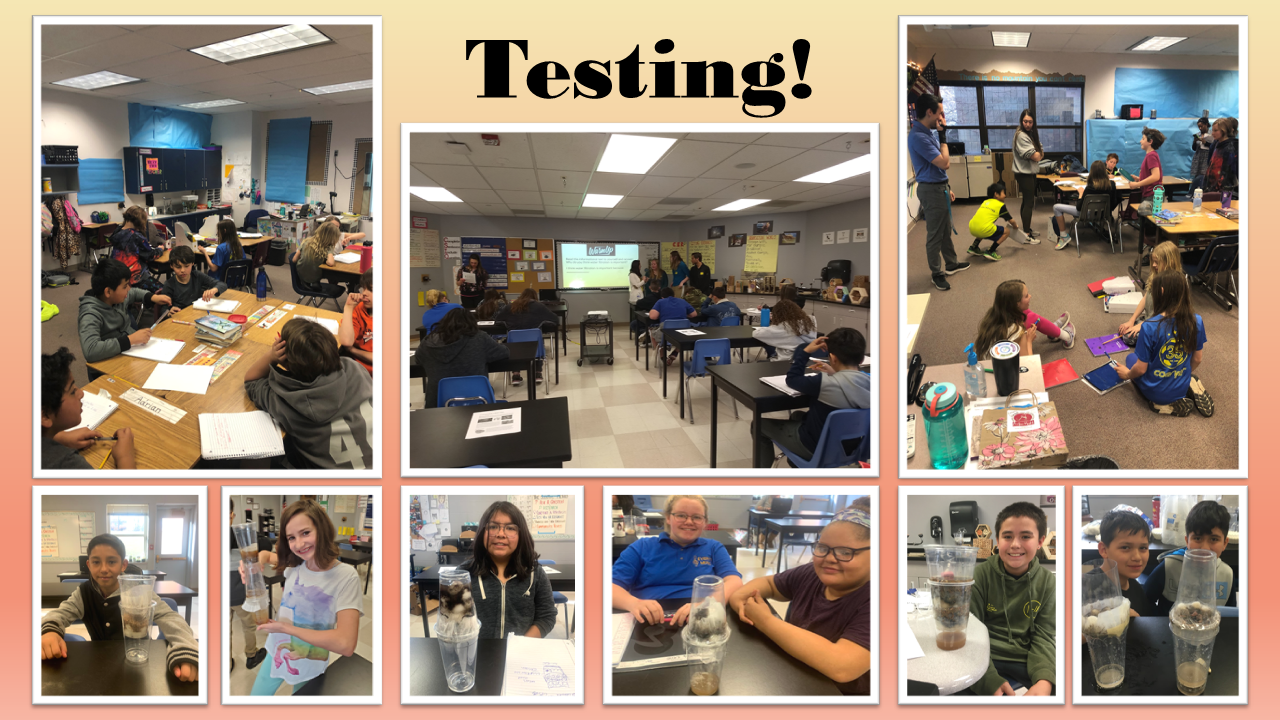
At Shelton Elementary School, we had a more in depth and personal approach with the students. We spent 3 days at the school with one STEM class to teach, build and reflect on the material. The module was less stressful and condensed. Lastly, we worked with Everitt middle school for one day. On this day we worked with four different classes in 45 minute periods. While the time spent was shortened, the kids were older and able to understand and grasp the concepts more quickly than the elementary schoolers. At both Shelton Elementary and Everitt Middle schools, the materials were provided.
The students at all of the schools were very creative and innovative in how they used the materials to create a water filter. Students used previous knowledge to predict what materials and in which order they would be the most effective in cleaning the water. Different approaches were taken with layering sand, rocks, cotton balls, as well as other materials. The goal for the students was to make the cleanest water using their filters, then figure out why or why not their filter worked. If time allowed, the students were allowed to iterate or adjust their protype, such as those shown below.
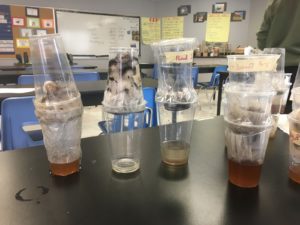
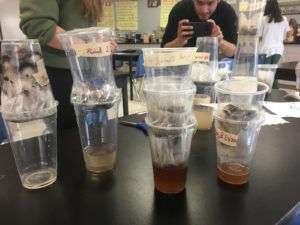
Feedback for our project was mostly positive. The only negative feedback we got was that the project required quite a few materials to collect, but they were all easily accessible to the teachers and budget friendly. They particularly enjoyed the options and suggestions in case things couldn’t be found or obtained. The teachers loved how hands on and applicable to daily life the program was and how it was able to show their students the importance of water. The reading material showed the importance of water and allowed the students to process why it mattered. The hands-on portion made the students think critically about how to best execute the activity using the scientific method. Our group also found that leak prevention and sealing the prototypes proved to be a difficult task and the spilled water needed to be cleaned up. This proved to be a great teaching point about properly sealing up pipes and why this is important for water treatment plants.
Next Steps
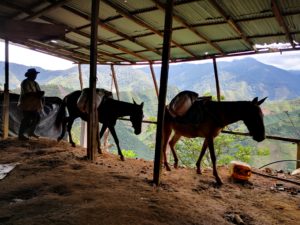
Unfortunately, due to unforeseen circumstances associated with the COVID-19 pandemic, we were unable to travel to Santa Rita to gain first-hand feedback on the work we have performed to this point. As such, the critical next step in this project will be to do similar class-tests that were performed at schools in Colorado with the school in Sant a Rita. Similarly, it will be important to speak to teachers at the school to gain feedback on how to best fit the module into their existing curriculum, adapt for differences in culture, and implement it most effectively.
After this is complete, adaptation of the curriculum must take place, incorporating the data garnered from all field testing performed. This stage is difficult to predict due to the fact that not all the feedback has been collected yet. Once the curriculum is successfully adapted, the final step will be training teachers and community members on how to implement it. The final educational materials will be handed to UNIMINUTO, and our partners will be able to utilize the work we have accomplished in order to adapt the module to other communities and their needs.
Meet the Team
Juliana Anderson
I am an environmental engineering major pursuing a minor in economics. I’ve always had a passion for STEM outreach programs ever since 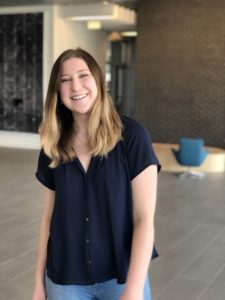 high school when I first got involved with a program at my local university to encourage young women and minorities to stay involved with STEM as they grow up. This senior design project follows in the same vein, and one of the most important and valuable components of our outreach is community input. Working on a project greater than myself means that the solution isn’t about me!
high school when I first got involved with a program at my local university to encourage young women and minorities to stay involved with STEM as they grow up. This senior design project follows in the same vein, and one of the most important and valuable components of our outreach is community input. Working on a project greater than myself means that the solution isn’t about me!
Madison Anderson
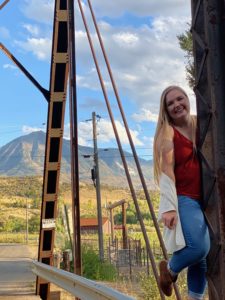 I am a senior civil engineering student also pursuing the McBride Honors Program minor in public affairs. Largely, the opportunity to interact with the community in Santa Rita, Colombia in order to obtain feedback on our preliminary design and prototypes will allow me the opportunity to integrate my public affairs minor more intimately into my technical education. I will be able to see the unseen aspects of the community— including the culture, community operations and interactions, and interactions with and within the environment— which will help the senior design team gain a further understanding of the complex human and natural systems our prototype will be designed for and integrated into.
I am a senior civil engineering student also pursuing the McBride Honors Program minor in public affairs. Largely, the opportunity to interact with the community in Santa Rita, Colombia in order to obtain feedback on our preliminary design and prototypes will allow me the opportunity to integrate my public affairs minor more intimately into my technical education. I will be able to see the unseen aspects of the community— including the culture, community operations and interactions, and interactions with and within the environment— which will help the senior design team gain a further understanding of the complex human and natural systems our prototype will be designed for and integrated into.
Emerson Collins
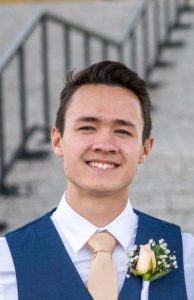 I am a mechanical engineering major. My goal is to use my degree to go overseas as a missionary and build sustainable systems for underdeveloped people groups. This project ties in extremely well to what I wish to do for the rest of my life. I believe that interacting with the community in Santa Rita will broaden my perspectives and create the necessary relationships for continuing with our design project. The need for STEM is prevalent in Colombia and I believe that by travelling to meet the people of the communities we will have a deeper understanding of how to properly implement our STEM education program.
I am a mechanical engineering major. My goal is to use my degree to go overseas as a missionary and build sustainable systems for underdeveloped people groups. This project ties in extremely well to what I wish to do for the rest of my life. I believe that interacting with the community in Santa Rita will broaden my perspectives and create the necessary relationships for continuing with our design project. The need for STEM is prevalent in Colombia and I believe that by travelling to meet the people of the communities we will have a deeper understanding of how to properly implement our STEM education program.
Arielle Rainey
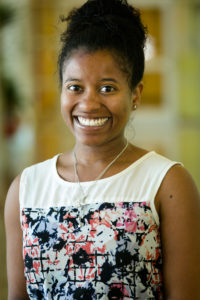 I am a student pursuing a major in environmental engineering. I was drawn towards this project because I’m very excited and passionate about my field of study and I feel inclined to spark that interest in others, especially the next generation. As a female minority at Mines, my experience here is something I truly desire to use as a tool to inspire other communities, especially ones underrepresented in STEM. Coming to Mines has allowed me to develop my engineering skills and gain valuable experience in problem solving and I feel motivated to share that with others.
I am a student pursuing a major in environmental engineering. I was drawn towards this project because I’m very excited and passionate about my field of study and I feel inclined to spark that interest in others, especially the next generation. As a female minority at Mines, my experience here is something I truly desire to use as a tool to inspire other communities, especially ones underrepresented in STEM. Coming to Mines has allowed me to develop my engineering skills and gain valuable experience in problem solving and I feel motivated to share that with others.
Bilal Reza
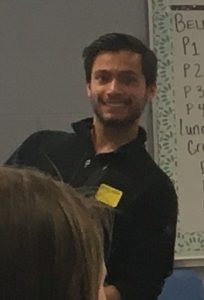 I am an Electrical Engineering major pursuing a minor in Humanitarian Engineering. I have a strong passion for both technology and education, particularly in implementing them in underserved communities. Being able to interact with the community in Santa Rita has undoubtedly provided unparalleled insight into the issues faced by community members, and is invaluable in developing an effective solution. This experience has likely enhanced not only the team’s goals for the project, but also my own experiences in the field of effective community development.
I am an Electrical Engineering major pursuing a minor in Humanitarian Engineering. I have a strong passion for both technology and education, particularly in implementing them in underserved communities. Being able to interact with the community in Santa Rita has undoubtedly provided unparalleled insight into the issues faced by community members, and is invaluable in developing an effective solution. This experience has likely enhanced not only the team’s goals for the project, but also my own experiences in the field of effective community development.
Alex Vo
 I am an environmental engineering major. By experiencing new cultures I have been better able to understand and respect other people. This skill is essential in the workplace and helps students to better communicate and work cohesively with others. Different cultures and backgrounds help to bring new perspectives and ideas to a problem and can help to get a better understanding of the approach to new problems. Being given the opportunity to engage in this project has spurred significant personal growth.
I am an environmental engineering major. By experiencing new cultures I have been better able to understand and respect other people. This skill is essential in the workplace and helps students to better communicate and work cohesively with others. Different cultures and backgrounds help to bring new perspectives and ideas to a problem and can help to get a better understanding of the approach to new problems. Being given the opportunity to engage in this project has spurred significant personal growth.
